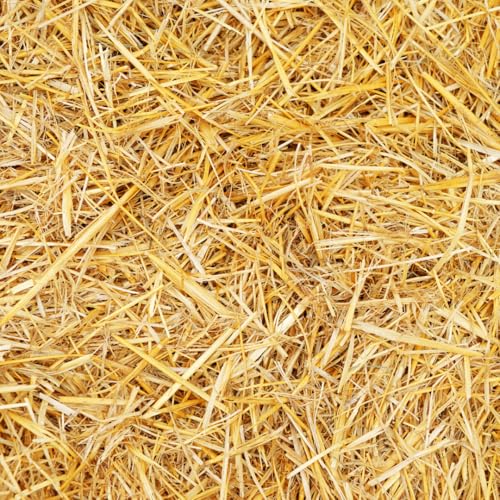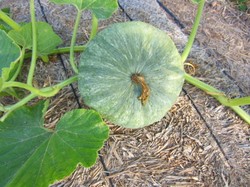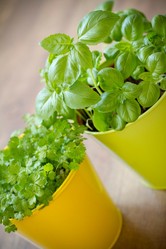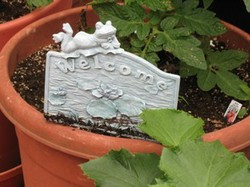Anything other than a tree or a bush can be grown on a bale. Plants that produce their edible sections above ground are easy. Thus peas and beans, cabbages, salad crops,pumpkins,and marrows for example are prime candidates for straw bale cultivation. Sweet corn will send its long root down into the depths of the bale to absorb nutrients. Onions and leeks also root shallowly and produce near crops to the surface, so there are no problems. Potatoes, parsnips and carrots,all root vegetables, can also be grown, for they are able to push down into the decaying straw. However,if you grow members of the Brassica family [cabbages, kale, cauliflower, broccoli, sprouts calabrese,turnips] you will need to add some lime, as this family requires a pH higher than other vegetables do, so if you do want to grow a range of vegetables,different straw bales for vegetables with difering requirements might be a good idea.
Some plants require staking, such as beans, and this can cause a problem, as stakes cannot be easily driven into a straw bale. The solution can be to fix stakes into the ground near the bale and fix the plants to them. This is likely to be the case with beans, peas and marrows. If the ground is too hard placing the bale near a mesh fence allows the plants to be tied to the fence
Certain vegetables are greedy feeders, such as pumpkins,so they will need a large dose of fertilizer. But the up-side of this is that members of the pumpkin family are well suited to straw bale cultivation. One large pumpkin per bale can be quite a nice little project that can allow you to specialize with different plants for different bales.
Herbs and salads can have the soil spread a few centimetres deep across the top of the bale, and these two kinds of easy-to grow-vegetables will happily thrive. However, some, especially root crops, will benefit from a small compost filled hole specially dug out of the straw surface into which the seedling can grow. Potatoes, especially,require some depth of soil and an application of manure,or failing that potato fertilizer. The manure applied can be in the form of liquid manure or pelleted manure, which can be purchased from garden centres and a variety of other outlets. Compost can also be liquidized and applied to the bale.













 TheThousand Year Gardenon 11/26/2025
TheThousand Year Gardenon 11/26/2025
 Women of the Gospelson 10/11/2025
Women of the Gospelson 10/11/2025
 Religious Gardenson 08/25/2025
Religious Gardenson 08/25/2025
 Doctor of the Church: John Henry Newmanon 08/03/2025
Doctor of the Church: John Henry Newmanon 08/03/2025



Comments
No. But a cheaper wood is more likely.
The third sentence under the first subheading, Principles of cultivation, advises us that "Sometimes they [straw bales] are encased in wooden containers to make what appears like a raised bed."
Is there a preferred wood for such containers?
There is a storm at the moment with 60 mph gusts. There is no damage at ground level, so it is likely that it would take gusts in excess of 60 mph to move anything heavy. Maureen came back from the shops and advised me to stay indoors, as my impaired balance is not suitable for strong wind conditions. But Britain generally gets gusty westerly winds.
It depends on the size of the bale. A big bale in a shelter place would be hard to move.
The second paragraph to the first subheading, The principles of cultivation, advises us that "they can be laid on a stone/paved surface. Sometimes they are encased in wooden containers to make what appears like a raised bed."
Is there any worry about strong winds -- quite common worries for western-ponders -- dislodging the straw bales?
Indeed, I am not tall enough for most things.
All members of the cucurbit family, to which squash and cucumber belong, are greedy feeders, so your soil might not have been fertile enough for them. They suck up water, and it is a known problem of container growing that containers and raised beds are prone to drying out quicker than soil does. You certainly could grow a squash in a straw bale, but be careful of the weight. I would roll the bale down your back path before you place it, or better still use some kind of trolley. You are not big enough to shift a bale. Nowadays, with my back being as it is, I would ask Andrew for help if I wanted to lift one.
I would soak the bale in liquid seaweed solution and also liquid fertilizer on several occasions during the growth period.
I haven't used straw bales. What a good idea. I often use containers to grow veg and have been fairly successful. My rhubarb, tomatoes and courgettes( zucchini ) do well ; but my cucumber and butternut squash didn't. Maybe straw bales would help these.
Iam glad that you liked it, Margielynn.
This is awesome, I have never heard of this before! Thanks for sharing, great page!